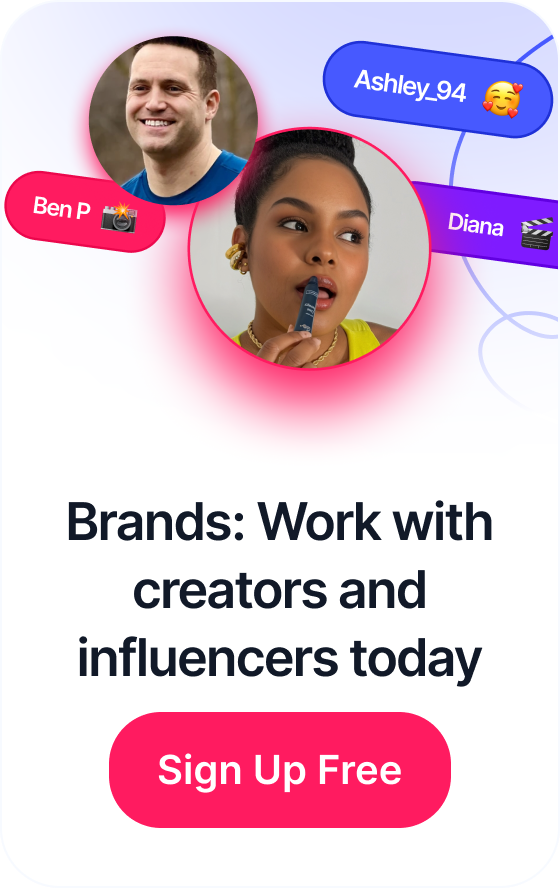 Top gmv tiktok creators: Your Brand’s Guide to 2025 Partnerships
Top gmv tiktok creators: Your Brand’s Guide to 2025 Partnerships
Ever feel like you're trying to conduct an orchestra with a broken baton? That’s what marketing can feel like without the right tools. You’ve got your social media team over here, your email squad over there, and your content and ad people all working from different song sheets. It’s chaotic.
Important details get lost in endless email chains, deadlines are a moving target, and figuring out what actually worked is a complete guessing game. This is exactly where most campaigns start to unravel.
Table of Contents
What Is Marketing Campaign Management Software?
Think of marketing campaign management software as the central command center that brings order to that creative chaos. It’s a single, unified platform designed to help you plan, execute, monitor, and analyze every moving part of your campaigns.
Instead of your team juggling a dozen different apps, they’re all working from the same playbook. This ensures everyone is on the same page about goals, timelines, and which creative assets to use.
It's More Than Just a Glorified To-Do List
This isn't just another project management tool with a fancy name. It’s built from the ground up for the specific, messy, wonderful world of marketing. These platforms are designed to help you:
- Centralize Your Plan: Forget scattered spreadsheets. You can create detailed campaign calendars that map out every single activity, from when a blog post goes live to how much you're spending on ads. Everyone gets a bird's-eye view of the entire strategy.
- Streamline Your Execution: A lot of marketing is repetitive. This software automates tedious tasks like scheduling social media posts or sending follow-up emails, freeing up your team to do what they do best: being creative and strategic.
- Boost Team Collaboration: It creates one space where your team can share feedback, approve content, and grab the latest version of an ad creative. No more confusion, no more delays. Our guide on effective digital marketing campaign management digs even deeper into these collaborative perks.
At its heart, this software is about turning marketing from a bunch of disjointed actions into a strategic, measurable, and scalable operation. It brings structure to your creative process without stifling it.
It's no surprise that the demand for these tools is exploding. The global market was valued at $5.3 billion in 2024 and is on track to hit $12.3 billion by 2033, according to market growth trends at verifiedmarketreports.com. That massive growth points to a simple truth: modern marketing is just too complex to manage without the right tech in your corner.
The Core Features That Drive Campaign Success

A good marketing campaign management software isn’t just a fancy to-do list or a digital filing cabinet. Its real power comes from a handful of core features designed to cut through the chaos, automate the grunt work, and deliver insights you can actually use.
Think of it like an orchestra. Each feature is a different instrument. They all have their own part to play, but when they work in sync, they create something powerful that truly connects with your audience.
Campaign Planning And Calendars
Every great campaign starts with a plan. A visual campaign calendar acts as the single source of truth for your entire team, clearly showing what's happening, when, and who's on point.
This feature gets your strategy out of messy spreadsheets and scattered documents, putting it into a live, interactive dashboard. A marketing manager can see an entire product launch mapped out in one view—from the first teaser email to the final social ad push. This kind of clarity prevents double-booking and makes sure all your channels are singing from the same hymn sheet.
Multi-Channel Execution
Modern marketing is rarely a one-channel show. A key job for campaign management software is to let you run and coordinate everything—email, social media, content, paid ads—from one central hub.
You can draft a blog post, schedule the social media promos for it, and prep the email newsletter that announces it, all without switching between ten different tabs. This unified approach keeps your messaging and branding consistent across every single customer touchpoint, which is absolutely essential for building a brand people recognize and trust.
Audience Segmentation And Personalization
The days of "one size fits all" marketing are long gone. The best platforms let you slice and dice your audience based on their behavior, demographics, or purchase history to send messages that actually feel personal.
- Behavioral Targeting: Send a discount to customers who bought a specific product six months ago.
- Demographic Segmentation: Show different ad creatives to users in different cities or age brackets.
- Engagement-Based Lists: Create a special nurture sequence for leads who watched a webinar but didn't buy.
This is what hyper-relevant marketing is all about. One study found that 76% of consumers are more likely to buy from brands that personalize their experience. That makes segmentation less of a "nice-to-have" and more of a must-have for boosting conversions. It's the difference between shouting into a crowd and having a real conversation.
A great platform doesn't just manage tasks; it empowers you to manage customer relationships at scale. It transforms raw data into personalized experiences that build loyalty and drive business growth.
Automation And Workflow Management
This is where you get your time back. Workflow automation takes on all the repetitive, manual tasks, freeing up your team to focus on big-picture strategy and creative ideas.
Just imagine setting up a workflow where a new lead automatically gets a welcome email series dripped out over two weeks. No one has to lift a finger.
These automated workflows are game-changers for lead nurturing, customer onboarding, and even internal processes. Streamlining tasks like getting content reviewed and approved is another huge win. For a deeper look, our guide on building a content approval workflow shows exactly how automation can smash bottlenecks and get your content out the door faster.
Strategic Benefits of Using This Software

Bringing new software into your workflow is a real commitment of time and money, so what’s the actual payoff? It's about more than just checking off tasks. Marketing campaign management software delivers some serious strategic wins that can directly fatten your bottom line. It’s the difference between running a bunch of disconnected activities and operating a slick, data-driven growth engine.
One of the first things you'll notice is a major boost in your campaign's return on investment (ROI). By pulling all your analytics from every channel into one place, you get a crystal-clear picture of what's working and what's totally bombing. That kind of clarity means you can stop throwing money at underperforming ads and double down on your winners. This is exactly what you need for accurately measuring marketing campaign effectiveness.
Create a Single Source of Truth
Let's be honest: when your team is juggling scattered spreadsheets, endless email chains, and a dozen different app logins, chaos is king. The solution is centralizing everything—from creative briefs to the final performance reports—to create a single source of truth.
This unified hub demolishes the silos between your teams. Your social media people, content writers, and paid ad specialists are all on the same page, working from the same up-to-date info. The result? Fewer mistakes, faster approvals, and collaboration that actually feels collaborative.
When you centralize your operations, you’re doing more than just organizing files. You’re building a transparent, collaborative space where your team can do their best work without all the usual friction.
This is where the magic happens. For example, one web SEO agency saw massive growth by using these kinds of tools for rapidly scaling content creation for campaigns. It's proof that a truly optimized workflow leads to incredible results.
Empower Your Team with Automation
Nothing kills creativity and morale faster than repetitive, mind-numbing manual tasks. Automation is the secret weapon that gives your marketing team their most precious resource back: their time.
Putting this software to work lets you automate key processes, which leads to some huge efficiency gains and, frankly, better campaigns.
- Lead Nurturing: Automatically fire off follow-up emails to new leads so no opportunity ever slips through the cracks.
- Social Media Scheduling: Plan and schedule your posts weeks ahead of time, ensuring you always have a consistent, active presence.
- Reporting: Generate performance reports on autopilot, freeing up your analysts to dig into strategy instead of just crunching numbers.
This shift allows your team to stop being task-doers and start being strategists, focusing on high-impact work like creative development and genuine customer engagement. This strategic focus is a huge driver behind the ad campaign software market’s projected growth from $13.65 billion in 2024 to $15.74 billion in 2025. Ultimately, a team that's less bogged down in busywork is a team that can create better customer experiences and build rock-solid brand loyalty.
How to Choose the Right Campaign Management Platform
Picking the right marketing campaign management software can feel like searching for a needle in a haystack. There are countless options out there, and every single one promises to be the magic bullet for your marketing woes. The secret isn't getting dazzled by flashy features; it's about focusing squarely on what your business actually needs.
A structured evaluation will take this overwhelming task and turn it into a clear, confident decision.
Look at Your Current Tech Stack First
Before you even start looking at new platforms, you need to look inward at your current marketing stack. What tools are you and your team already using every single day?
Think about your CRM, analytics platform, design software, and any other systems you can't live without. A new platform has to play nicely with these existing tools. If it doesn't integrate smoothly, you'll end up creating frustrating data silos or clunky manual workarounds. A lack of integration can turn a promising solution into a major bottleneck, fast.
Assess Your Team and Define Your Budget
Next, think about the people who will actually be in the software day in and day out. Is your team full of tech wizards, or do they need a simple, intuitive interface to get things done? A super-powerful platform with a steep learning curve might get abandoned if it’s just too hard to use. Always prioritize a great user experience (UX) and check for accessible, responsive customer support—you'll be thankful for it later.
Once you’ve got a handle on your technical and user needs, it’s time to talk money. Pricing for these platforms is all over the map:
- Per-User Pricing: You pay a monthly fee for each person on your team who needs access. Simple.
- Tiered Pricing: Plans are based on things like the number of contacts in your database or how many features you unlock.
- Flat-Rate Pricing: One price gives you access to everything, no matter how big your team or contact list gets.
Be realistic about what you can spend, but also think about the future. The cheapest option today isn’t always the best value if it can't scale with you as your business grows.
Create a Vendor Comparison Checklist
To make a truly objective decision, you need a checklist to score potential vendors against each other. This structured approach stops you from being swayed by a slick sales demo and forces you to compare platforms on the criteria that really matter to your business.
For instance, this decision tree shows a simple framework for measuring campaign outcomes, a core function of any platform worth its salt.

As the visual shows, evaluating a campaign isn't a one-shot deal. It starts with ROI but then drills down into engagement and conversion rates to give you the full picture.
To help you get started, I’ve put together a simple table you can adapt to compare your top contenders. Rate each point on a scale of 1 to 5, where 5 is a perfect fit.
Software Selection Criteria Checklist
This checklist is designed to help you methodically evaluate and score potential software vendors. By assigning a score to each criterion, you can build an objective comparison that highlights the best overall fit for your team and business goals.
| Evaluation Criterion | Vendor A Score (1-5) | Vendor B Score (1-5) | Notes |
|---|---|---|---|
| Integration with CRM | 4 | 3 | Vendor A offers a native integration. |
| User-Friendliness (UX) | 5 | 4 | Team found Vendor A's demo very intuitive. |
| Customer Support Quality | 4 | 5 | Vendor B has 24/7 chat support. |
| Scalability for Growth | 3 | 5 | Vendor B's enterprise plan is robust. |
| Pricing Model Value | 4 | 4 | Both are competitive; depends on user count. |
After filling this out for your top choices, a clear winner often emerges. It takes the emotion out of the decision and focuses on the data.
By systematically evaluating your needs, budget, and the real-world capabilities of each platform, you transform a complex choice into a strategic business decision. This diligent approach ensures the marketing campaign management software you select will be a true asset—not just another monthly subscription.
Best Practices for Implementation and Adoption
Let's be honest: even the most incredible marketing campaign management software is just expensive shelfware if your team refuses to use it. A successful launch isn't about just flipping a switch one day. It’s about carefully guiding your people through the change.
Think of the implementation process as its own mini-campaign. Your audience? Your colleagues. Your goal? To win them over.
Don't go for a "big bang" launch where everyone gets thrown into the deep end at once. That's a recipe for chaos. Instead, opt for a phased rollout. Start small. Pick a single, upcoming project and assign a small, cross-functional pilot team to use the new software. This approach keeps the learning curve manageable and lets you iron out any workflow kinks or integration hiccups on a much smaller scale.
Getting Your Team On Board
Adoption lives and dies by team buy-in. You need to get everyone, from the top down, excited about the change. This means clearly explaining the "why" behind the new tool.
Don't just rattle off a list of features. Instead, talk about how it will make their lives easier. Explain how it will kill off tedious tasks, get rid of frustrating bottlenecks, and ultimately help everyone hit their goals without the usual headaches.
Once you have their attention, it’s time for training. But not just any training—it needs to be tailored to their specific roles. A social media manager has very different needs from a content writer or a data analyst.
- Hands-On Workshops: Run interactive sessions where everyone can build a mock campaign from scratch.
- On-Demand Resources: Create a simple library of short video tutorials and quick-reference guides they can access anytime.
- Office Hours: Set aside regular, casual drop-in times where team members can pop in and ask questions.
The global market for these tools is projected to nearly double, hitting $10.86 billion by 2032. This isn't just a random statistic; it shows a massive industry-wide move towards efficiency. You can frame it this way: learning this software isn't just a company mandate, it's a career-enhancing skill. For a closer look at these trends, check out the latest campaign management system market analysis at coherentmarketinsights.com.
Making It Stick for the Long Haul
To make sure this new software becomes a core part of how you work, you need to maintain momentum long after the initial training wraps up. The key is to find and empower internal "champions." These are the enthusiastic users who "get it" early on. They can offer peer-to-peer support and share their own success stories, which is often far more convincing than a memo from management.
The final piece of the puzzle is building a culture of continuous learning. Don't let the conversation die down. Regularly share tips, highlight cool new features, and showcase impressive campaign results that were achieved using the platform.
To truly squeeze every drop of value from your investment, it's vital to follow established marketing automation best practices. Following these guidelines ensures the tool doesn't just get used—it gets mastered, becoming the powerful engine that drives all your marketing efforts forward.
Frequently Asked Questions

Even with all the features and benefits laid out, you probably still have a few questions rattling around. That's totally normal. This section is here to tackle the most common things people wonder about marketing campaign management software, giving you straight answers to clear up any lingering doubts.
Let's cut through the noise about different platform types, figure out if these tools actually work for smaller teams, and set some realistic expectations for what kind of return you can expect.
What Is the Difference Between Campaign Software and a CRM?
This is a big one, and it's easy to get them mixed up because they're often used together. The simplest way to think about it is this: your CRM is your digital rolodex and relationship tracker. It's built to manage individual, one-on-one customer interactions and keep a history of their journey with your business.
Campaign management software, on the other hand, is your broadcast system. It’s the tool you use to talk to groups of people from that rolodex, all at once. Its job isn't to track a single sales call, but to plan, launch, and measure big-picture marketing efforts across email, social media, ads, and more.
A CRM is customer-centric; it's all about managing relationships. Campaign software is marketing-centric; it's about orchestrating campaigns and seeing how your audience responds. The magic happens when they're integrated, letting your campaign tool pull perfectly segmented lists straight from the CRM.
Is This Software Suitable for Small Businesses?
Absolutely. Let's bust that myth right now: this kind of powerful software isn't just for mega-corporations anymore. Far from it. Many of today's best platforms offer flexible, affordable plans built specifically with small and medium-sized businesses (SMBs) in mind.
For a small team, the time savings alone can be a game-changer. These tools automate the tedious, time-sucking tasks that bog you down, letting you punch way above your weight without having to hire a massive marketing department.
- Core Power: You get access to essentials like email marketing, social media scheduling, and simple automation that can free up hours every single week.
- Grows With You: You can start on a basic plan and add more advanced features as your business—and your marketing ambitions—grow.
- Level the Playing Field: It gives you access to the same kind of strategic tools your bigger competitors are using to stay organized and connect with their audience.
The trick is to find a platform that's user-friendly and has great support. You want a tool that feels more like a partner than just another piece of software.
How Long Does It Take to See a Return on Investment?
While every business is a bit different, you can generally expect to see your ROI roll in across two distinct phases.
The first wave usually hits within the first 3 to 6 months. This is your "efficiency ROI." You'll see it in the time your team gets back from automating repetitive work and the hours saved by having a central place for planning instead of endless meetings. These are real, tangible savings.
The bigger, revenue-focused ROI typically starts to become clear within 6 to 12 months. By this point, you've had time to run a few campaigns, gather solid data, and start making smarter decisions based on what the analytics are telling you. This is when you see the results in higher-quality leads, better conversion rates, and a measurable lift in sales.
What Are the Most Common Implementation Challenges?
Funnily enough, the biggest roadblocks rarely have anything to do with the technology itself. It almost always comes down to people and processes. Getting the launch right means planning for the human side of the change.
The top three hurdles we see businesses stumble over are:
- Garbage In, Garbage Out: The software is only as smart as the data you give it. If your customer lists are a mess of outdated, incomplete, or inaccurate info, your campaigns are doomed from the start.
- Lack of Team Buy-In: If your team sees the new tool as "just another thing to learn" instead of something that makes their jobs easier, you'll face an uphill battle with adoption. Clear communication and proper training are non-negotiable.
- Failure to Integrate: Trying to use a campaign platform in a vacuum is a recipe for frustration. If it doesn't talk to your other key systems, especially your CRM, you just end up with data silos and manual workarounds, which defeats the whole purpose.
Get your data clean, get your team on board, and get your systems connected from day one. That’s the formula for a smooth rollout and a successful future.
Ready to unify your content creation and influencer marketing into a single, powerful workflow? JoinBrands connects you with over 250,000 creators to amplify your social presence and accelerate sales. Start your campaign today and see the difference.








